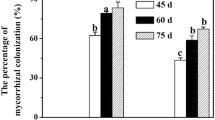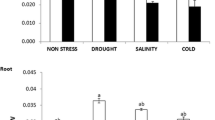Abstract
The influence of the arbuscular mycorrhizal (AM) fungus, Glomus fasciculatum, on the growth, heat stress responses and the antioxidative activity in cyclamen (Cyclamen persicum Mill.) plants was studied. Cyclamen plants (inoculated or not with the AM fungus) were placed in a commercial potting media at 17–20 °C for 12 weeks in a greenhouse and subsequently subjected to two temperature conditions in a growth chamber. Initially, plants were grown at 20 °C for 4 weeks as a no heat stress (HS−) condition, followed by 30 °C for another 4 weeks as a heat stress (HS+) condition. Different morphological and physiological growth parameters were compared between G. fasciculatum-inoculated and noninoculated plants. The mycorrhizal symbiosis markedly enhanced biomass production and HS + responses in plants compared to that in the controls. A severe rate of leaf browning (80–100 %) was observed in control plants, whereas the mycorrhizal plants showed a minimum rate of leaf browning under HS + conditions. The mycorrhizal plants showed an increase activity of antioxidative enzymes such as superoxide dismutase and ascorbate peroxidase, as well as an increase in ascorbic acid and polyphenol contents. The 2,2-diphenyl-1-picrylhydrazyl radical scavenging activity also showed a greater response in mycorrhizal plants than in the control plants under each temperature condition. The results indicate that in cyclamen plants, AM fungal colonisation alleviated heat stress damage through an increased antioxidative activity and that the mycorrhizal symbiosis strongly enhanced temperature stress tolerance which promoted plant growth and increased the host biomass under heat stress.







Similar content being viewed by others
References
Alguacil MM, Hernandez JA, Caravaea F, Portillo B, Roldan A (2003) Antioxidant enzyme activities in shoots from three mycorrhizal shrub species afforested in a degraded semi-arid soil. Physiol Plant 118:562–570
Asada K (1999) The water-water cycle in chloroplasts: scavenging of active oxygens and dissipation of excess photons. Annu Rev Plant Physiol Plant Mol Biol 50:601–639
Augé RM (2001) Water relations, drought and vesicular-arbuscular mycorrhizal symbiosis. Mycorrhiza 11:3–42
Ball GV (1991) Cyclamen (Cyclamen persicum) In: Ball GV (ed.) The Ball redbook, 15th edn. Geo J. Ball, Chicago, pp 475-481
Baumann K, Schneider BU, Marschner P, Hüttl RF (2005) Root distribution and nutrient status of mycorrhizal and non-mycorrhizal Pinus sylvestris L. Seedlings growing in a sandy substrate with lignite fragments. Plant Soil 276:347–357
Ben Khaled L, Gomez AM, Ourraqi EM, Oihabi A (2003) Physiological and biochemical responses to salt stress of mycorrhized and/or nodulated clover seedlings (Trifolium alexandrinum L.). Agron 23:571–580
Beyer WF, Fridovich I (1987) Assaying for superoxide dismutase activity: some large consequences of minor changes in conditions. Anal Biochem 161:559–566
Borland A, Elliott S, Patterson S (2006) Are the metabolic components of crassulacean acid metabolism up-regulated in responses to an increase in oxidative bueden? J Exp Bot 57:319–328
Bors W, Michel C, Saran M (1994) Flavonoids antioxidants: rate constants for reactions with oxygen radicals. Methods Enzymol 234:420–429
Burits M, Bucar F (2000) Antioxidant activity of Nigella sativa essential oil. Phytother Res 14:323–328
Compant S, van der Heijden MGA, Sessitsch A (2010) Climate change effects on beneficial plant-microorganism interactions. FEMS Microbial Ecol 73:197–214
Elmer WH, McGovern RJ (2004) Efficacy of integrating biologicals with fungicides for the suppression of Fusarium wilt of cyclamen. Crop Prot 23:909–914
Goto T, Shimizu N, Morishita T, Fujii K, Nakano Y, Shima K (2011) Effects of polyethylene pot removal and irrigation method on growth and flowering of garden-type cyclamen. Acta Hortic 886:83–90
Grace SC (2005) Phenolics and antioxidants. In: Smirnoff N (ed) Antioxidants and reactive oxygen species in plants. Oxford, UK, pp 141-168
Grover M, SkZ A, Sandhya V, Rasul A, Venkateswarlu B (2011) Role of microorganisms in adaptation of agriculture crops to abiotic stresses. World J Microbiol Biotechnol 27:1231–1240
Hajiboland R, Aliasgharzadesh N, Laiegh FS, Poschenrieder C (2010) Colonization with arbuscular mycorrhizal fungi improves salinity tolerance of tomato (Solanum lycopersicum L.) plants. Plant Soil 331:313–327
Hichem H, Mounir D, Naceur EA (2009) Differential responses of two maize (Zea mays L.) varieties to salt stress: changes on polyphenols composition of foliage and oxidative damages. Ind Crops Prod 30:144–151
Horemans N, Foyer CH, Potters G, Asard H (2000) Ascorbate function and associated transport systems in plants. Plant Physiol Biochem 38:531–540
Jaleel CA, Riadh K, Gopi R, Manivannan P, Inès J, Al-Jaburi HJ, Zhao CX, Shao HB, Panneerselvam R (2009) Antioxidant defense responses: physiological plasticity in higher plants under abiotic constraints. Acta Physiol Plant 31:427–436
Karlsson M, Werner J (2001a) Temperature affects rate of leaf unfolding and flowering in cyclamen. HortScience 36:292–294
Karlsson MG, Werner JW (2001b) Temperature after flower initiation affects morphology and flowering of cyclamen. Sci Hortic 91:357–363
Latef AAHA, Chaoxing H (2011) Arbuscular mycorrhizal influence on growth, photosynthetic pigments, osmotic adjustment and oxidative stress in tomato plants subjected to low temperature stress. Acta Physiol Plant 33:1217–1225
Liu A, Wang B, Hamel C (2004) Arbuscular mycorrhiza colonization and development at suboptimal root zone temperature. Mycorrhiza 14:93–101
Martin CA, Stutz JC (2004) Interactive effects of temperature and arbuscular mycorrhizal fungi on growth, P uptake and root respiration of Capsicum annum L. Mycorrhiza 14:241–244
Marxen K, Vanselow KH, Lippemeier S, Hintze R, Ruser A, Hansen UP (2007) Determination of DPPH radical oxidation caused by methanolic extracts of some microalgal species by linear regression analysis of spectrophotometric measurements. Sensors 7:2080–2095
Matsubara Y (2010) High temperature stress tolerance and the changes in antioxidative ability in mycorrhizal strawberry plants. In Abigail N, Sampson (ed) Horticulture in the 21st century. Nova Science, New York, pp 179-192
Matsubara Y, Harada T (1996) Effect of constant and diurnally fluctuating temperatures on arbuscular mycorrhizal fungus infection and the growth of infected asparagus (Asparagus officinalis L.) seedlings. J Japan Soc Hortic Sci 65:565–570
McDonald S, Prenzler PD, Autolovich M, Robards K (2001) Phenolic content and antioxidant activity of olive oil extracts. Food Chem 73:73–84
Miransari M, Bahrami HA, Rejali F, Malakouti MJ (2008) Using arbuscular mycorrhiza to alleviate the stress of soil compaction on wheat (Triticum aestivum L.) growth. Soil Biol Biochem 40:1197–1206
Mittler R (2002) Oxidative stress, antioxidants and stress tolerance. Trends Plant Sci 7:405–410
Mukherjee SP, Choudhouri MA (1983) Implications of water stress-induced changes in the levels of endogenous ascorbic acid and hydrogen peroxide in Vigna seedlings. Physiol Plant 58:166–170
Nahiyan ASM, Matsubara Y (2012) Tolerance to fusarium root rot and changes in antioxidative ability in mycorrhizal asparagus plants. Hortscience 47:356–360
Nakano Y, Asada K (1981) Hydrogen peroxide is scavenged by ascorbate specific peroxides in spinach chloroplasts. Plant Cell Physiol 22:867–880
Noctor G (2006) Metabolic signaling in defense and stress: the central roles of soluble redox couples. Plant Cell Environ 29:409–425
Phillips JM, Hayman DS (1970) Improved procedures for clearing roots and staining parasitic and vesicular-arbuscular mycorrhizal fungi for rapid assessment of infection. Trans Br Mycol Soc 55:158–163
Porcel R, Barea JM, Ruiz-Lozano JM (2003) Antioxidant activities in mycorrhizal soybean plants under drought stress and their possible relationship to the process of nodule senescence. New Phytol 157:135–143
Potters G, De Gara L, Asard H, Horemans N (2002) Ascorbate and glutathione: guardians of the cell cycle, partners in crime? Plant Physiol Biochem 40:537–548
Prior RL, Cao G (1999) In vivo total antioxidant capacity: comparison of different analytical methods. Free Radical Bio Med 27:1173–1181
Sairam RK, Srivastava GC, Saxena DC (2000) Increased antioxidant activity under elevated temperature: a mechanism of heat stress tolerance in wheat genotypes. Biol Plant 43:245–251
Sánchez-Moreno C, Larrauri JA, Saura-Calixto F (1999) Free radical scavenging capacity and inhibition of lipid oxidation of wines, grape juices and related polyphenolic constituents. Food Res Int 32:407–412
Shokri S, Maadi B (2009) Effect of arbuscular mycorrhizal fungus on the mineral nutrition and yield of Trifolium alexandrinum plants under salinity stress. J Agron 8:79–83
Smith SE, Read DJ (2008) Mycorrhizal symbiosis. Academic, London
Tabata K, Oba K, Suzuki K, Esaka M (2001) Generation and properties of ascorbic acid-deficient transgenic tobacco cells expressing antisense RNA for L-galactono-1,4-lactone dehydrogenase. Plant J 27:139–148
Tanou G, Molassiotis A, Diamantidis G (2009) Induction of reactive oxygen species and necrotic death-like destruction in strawberry leaves by salinity. Environ Exp Bot 65:270–281
Venkateswarlu B, Shanker AK (2009) Climate change and agriculture: adaptation and mitigation strategies. Indian J Agron 54:226–230
Wahid A, Gelani S, Ashraf M, Foolad MR (2007) Heat tolerance in plants: an overview. Environ Exp Bot 61:199–223
Weih M, Karlsson PS (1999) Growth response of altitudinal ecotypes of mountain birch to temperature and fertilisation. Oecologia 119:16–23
Wu QS, Xia RX, Zou YN (2006) Reactive oxygen metabolism in mycorrhizal and non-mycorrhizal citrus (Poncirus trifoliata) seedlings subjected to water stress. J Plant Physiol 163:1101–1110
Wu G, Wei ZK, Shao HB (2007) The mutual responses of higher plants to environment: physiological and microbiological aspects. Biointerfaces 59:113–119
Yesson C, Culham A (2006) A phyloclimatic study of cyclamen. BMC Evol Biol 6:72
Zhu X, Song F, Xu H (2010a) Influence of arbuscular mycorrhiza on lipid peroxidation and antioxidant enzyme activity of maize plants under temperature stress. Mycorrhiza 20:325–332
Zhu XC, Song FB, Xu HW (2010b) Arbuscular mycorrhizae improves low temperature stress in maize via alterations in host water status and photosynthesis. Plant Soil 331:129–137
Zhu XC, Song FB, Liu SQ, Liu TD (2011) Effects of arbuscular mycorrhizal fungus on photosynthesis and water status of maize under high temperature stress. Plant Soil 346:189–199
Author information
Authors and Affiliations
Corresponding author
Rights and permissions
About this article
Cite this article
Maya, M.A., Matsubara, Yi. Influence of arbuscular mycorrhiza on the growth and antioxidative activity in cyclamen under heat stress. Mycorrhiza 23, 381–390 (2013). https://doi.org/10.1007/s00572-013-0477-z
Received:
Accepted:
Published:
Issue Date:
DOI: https://doi.org/10.1007/s00572-013-0477-z




